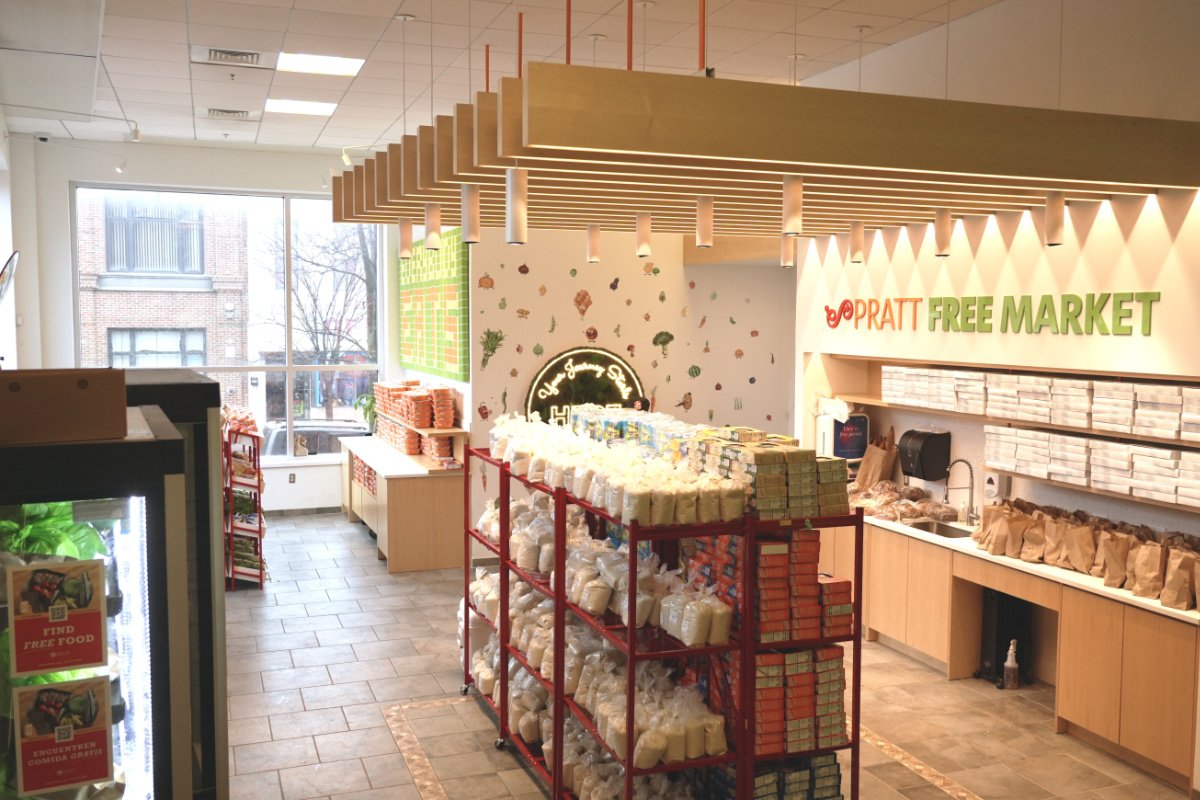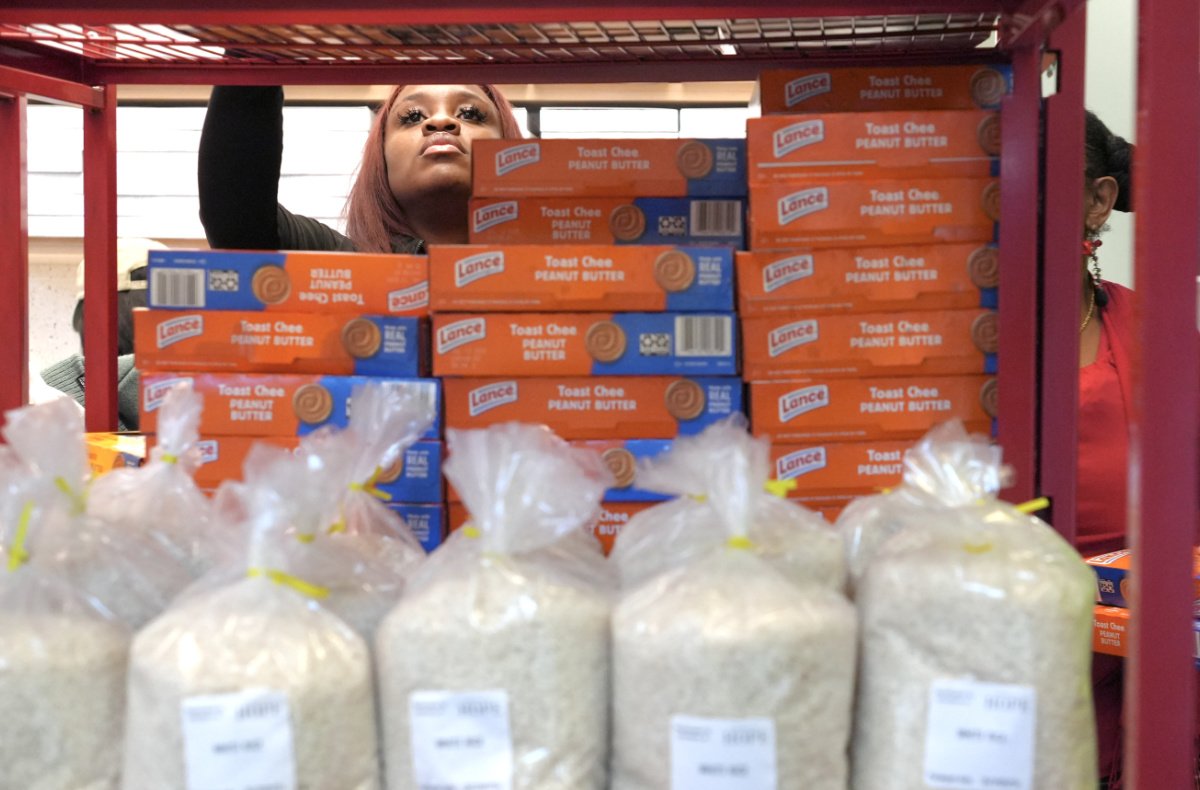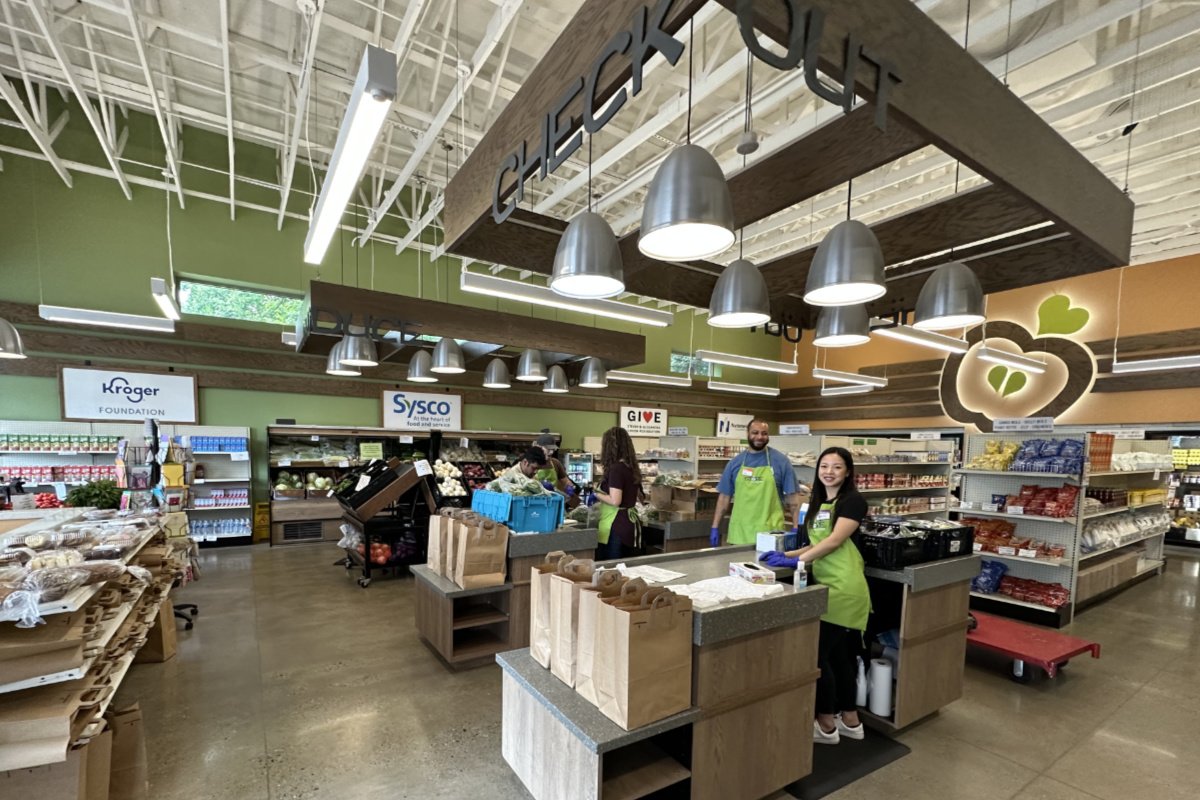A growing number of free grocery stores offer shoppers not just free food, but choice, ambiance, and space for dignity, too.

A growing number of free grocery stores offer shoppers not just free food, but choice, ambiance, and space for dignity, too.
April 14, 2025

Pratt Free Market is located inside a public library in Baltimore. (Photo credit: Sam Delgado)
More than 50 people stood outside the Enoch Pratt Library’s Southeast Anchor branch on a recent spring morning in Baltimore. Parents with small children, teenagers, and senior citizens clustered outside the door and waited to hear their ticket numbers called.
Expand your understanding of food systems as a Civil Eats member. Enjoy unlimited access to our groundbreaking reporting, engage with experts, and connect with a community of changemakers.
Already a member?
Login
They weren’t there for books—at least, not at that moment. They came to shop for groceries.
Connected to the library, the brightly painted market space is small but doesn’t feel cramped. Massive windows drench it in sunshine. In a previous life, it was a café. Now, shelves, tables, counters, and a refrigerator are spread out across the room, holding a mix of produce and shelf-stable goods.
Every fourth Friday, Pratt Free Market turns into “Pantry on the Go!”, a farmers’ market-style setup outside the library that offers fruits and vegetables.
That day, as staff and volunteers took their stations, shoppers walked in and filled their bags with what was in stock. On any given day, there’s a range of produce, like collard greens, apples, onions, radishes, potatoes, and cherry tomatoes, plus eggs, orange juice, rice, bread, and treats like cookies and peanut butter crackers. As they exited, shoppers did not need to pull out their wallets: No one pays at Pratt Free Market.
Launched in the fall of 2024, Pratt Free Market opens its doors every Wednesday and Friday and serves around 200 people per day. Anyone can pick up food at the store without providing identification or meeting income requirements. The library-based free grocery store was pitched by M’balu “Lu” Bangura when she started her role as Enoch Pratt Library’s chief of equity and fair practices. The idea stemmed from the food insecurity she saw during the COVID-19 pandemic.
“Seeing people hungry just never sat right with me,” said Bangura. “People shouldn’t have to stress about this.”
The Trump administration’s rampant cuts across government agencies have heightened concerns about the future of food security in the U.S. In March, the U.S. Department of Agriculture (USDA) cancelled two local food programs that connected small farms to food banks and schools.
Republican lawmakers have also proposed significant cuts to the Supplemental Nutrition Assistance Program (SNAP), a critical resource that helps low-income consumers purchase food. Economists also say that President Trump’s recent tariff policy on major agricultural trade partners will only cause the cost of food to rise—during a time when food prices were already projected to increase.
The combination of slapping tariffs on food trade partners and cutting aid programs seems like a perfect way to exacerbate an ongoing hunger problem in the U.S. In 2023, one in seven households faced food insecurity at some point in the year. For Baltimore residents, 28 percent reported experiencing food insecurity last year—twice the national average. Bangura described a time when a group of nurses came to Pratt Free Market on their lunch break, looking to pick up some food. She says that other working people have done the same.

On a recent Friday, the Pratt Free Market was stocked with radishes, apples, onions, eggs, salad mix, and other grocery items. (Photo credit: Sam Delgado)
Free grocery stores, like food pantries and community fridges, offer food at no cost to community members. But unlike other food charity models, free grocery stores often put more emphasis on the physical environment and service.
Just like regular markets, these dedicated spaces are bright, open, and filled with shelves and fridges holding a mix of food and household items, and customers choose what they want. A traditional food pantry may not have an appealing atmosphere, and community refrigerators have limited space and choices. By simulating the grocery store shopping experience, the free stores offer more than just food; they create space for dignity, too.
Pratt Free Market isn’t alone in this model. While some free grocery stores—like Unity Shoppe in Santa Barbara and World Harvest in Los Angeles—have been around for a while, others have popped up in recent years, including The Store in Nashville, Today’s Harvest just outside Minneapolis, the UMMA Center’s Harvest Market in Chicago, and San Francisco’s District 10 Community Market and Friday Farm Fresh Market.
The groceries that line the shelves and refrigerators inside Pratt Free Market vary from week to week, depending on who drops off food. Bangura says the vast majority of their food is purchased from a variety of sources, including the Maryland Food Bank and Plantation Park Heights, a local urban farm. The market sources its non-perishables and household or personal items, like deodorant, from Blessings of Hope, a Pennsylvania-based food redistribution organization.

Raquel Cureton, a program assistant at Pratt Library, stocked the shelves at Pratt Free Market before doors opened to the public. (Photo credit: Sam Delgado)
The funding for these purchases comes entirely from donations to Pratt Library, which are then split amongst the library’s different programs and initiatives, including Pratt Free Market. The library also receives donated food from Leftover Love, a Baltimore nonprofit that rescues food from local businesses that would otherwise go to waste.
On really good days, Bangura says, the market offers a mix of everything—from healthy, fresh produce to sweets like donuts. And every fourth Friday, the marker turns into “Pantry on the Go!”, a farmers’ market-style setup outside the library that offers fruits and vegetables. Last month, Bangura said they handed out onions, sweet potatoes, watermelons, celery, and apples.
As with most philanthropic efforts, volunteers are at the heart of Pratt Free Market’s operations. Gwendolyn Myers, a retiree who lives in the neighborhood, has volunteered with the free grocery store since they opened. She sees her work as a way to give back to her community, and she even brings extra bags of food to her elderly neighbors who aren’t able to leave their homes.
“A little bit of food, it helps,” Myers said. “Times are hard, and they’re going to get harder.”
About 700 miles from Baltimore, in Nashville, Tennessee, The Store has the look and feel of a grocery store—it’s well-lit, spacious, and stocked with an even mix of fresh foods like fruits, vegetables, meat, and dairy, alongside shelf-stable items like oatmeal and rice. It even offers items like flowers and greeting cards. And just like at Pratt Free Market, its shoppers pay nothing.

Inside The Store in Nashville, which looks and feels like a regular grocery store. (Photo courtesy of The Store)
With funding coming from grants, corporate sponsorships, fundraising events, and individual donors, The Store also purchases most of its food, with a small portion donated. Sarah Goodrich, The Store’s operations director, says they source their food and ingredients from partners like Second Harvest Food Bank, the national produce distributor FreshPoint, and various local farms.
The Store opened in March 2020, during a distinctly difficult time for Tennessee and the country at large. Days before their launch, a deadly set of tornadoes devastated parts of Nashville and Middle Tennessee. Then, the staff received more difficult news: a nationwide lockdown was in place as the pandemic upended everything.
But the back-to-back adversities didn’t stop The Store from helping people access food. “We very quickly had to pivot our model,” said Mari Clare Derrick, The Store’s volunteer director. They switched to delivering food, and in that first year, served over a million meals.
Five years later and in spite of a tumultuous start, The Store’s doors are still open. People with incomes up to twice the federal poverty level can enroll to shop there. Participants are then split into a bi-weekly schedule, and each group alternates every other week. Over email, Goodrich added that more than 870 households are currently enrolled, and while the program is full, they’re working to expand their capacity by establishing another location.
Goodrich says that the “secret recipe” for solving social problems, like hunger, is collaboration and partnerships. The Store has dozens of “referral partners,” or organizations that work closely with vulnerable populations, like families transitioning into housing, formerly incarcerated individuals, and victims of domestic violence. These partner groups can refer their clients and patients to The Store, which can guide their shoppers to these organizations for help as needed.
Having the institutional backing of a Baltimore public library made it possible to launch the Pratt Free Market. “Because this is under [Enoch Pratt Library], I’m able to build partnerships with community organizations who want to come in,” says Bangura. “They want to work with us, and they want to bring their volunteers.”
Taking advantage of its affiliation with the library, the Pratt Free Market aims to connect shoppers to other library-run social initiatives, like Project ENCORE, which helps formerly incarcerated individuals re-enter society, and additional wrap-around services, including in-library social workers, lawyers, and housing navigators.
Unlike other food charity models, free grocery stores put a little more emphasis on the physical environment and service.
Using the library’s resources means access to a large and consistently available space, and the ability to offer more food and serve more people than a smaller intervention like a community refrigerator could. Having a market also allows the community to give feedback about what’s offered, unlike with a community fridge. (The library does have a community refrigerator at three other branches, all stocked with produce from Maryland-based Moon Valley Farm.)
Shopper input is a key part of the free grocery store model. When stocking the store, Bangura considers what products seem to be popular, including non-food items. “My dream and vision was always that this would look like a mini grocery store,” said Bangura. “Many grocery stores have things like deodorant, dish detergent, and soap.” She added that Pratt Free Market has a feminine hygiene dispenser, supplied by organic menstrual product company Femly.
Having a welcoming, communal, in-person space has also allowed for relationships to be built between free grocery store staffers, volunteers, and the communities they serve. Goodrich says that store organizers listen to their shoppers and conduct surveys to learn what foods and items to purchase.
As the Trump administration dismantles federal food and hunger assistance initiatives, advocates see the impacts, and they’re troubling.
“There are millions of children living in food-insecure households,” said Alexis Bylander, interim child nutrition programs and policy director at the Food Research and Action Center (FRAC). “This is just a really terrible time to end those kinds of programs.”
On top of cuts to the programs, the consumer choices of SNAP recipients have also been a topic of discussion among policymakers. Representative Nancy Mace (R-South Carolina) posted on X that it wasn’t the government’s responsibility to “pay for someone else’s soda.”
“You want a soda? Get a job and go buy it yourself,” Mace wrote.
Though Mace alludes to SNAP recipients choosing “unhealthy” foods, restricting options for beneficiaries does nothing to address affordability or accessibility, says Salaam Bhatti, SNAP director at FRAC. “If your goal is for people to eat healthier, you have to understand that the healthier food is the most expensive food in a grocery store,” he said. “If you really want people to buy better food, then increase the SNAP benefit, because right now, it’s only an average of $6 per person per day.”
“I don’t think that I’m going to cure world hunger. But I could help one person eat their next meal. And that’s enough for me.”
The Trump administration’s ongoing and looming funding slashes haven’t affected The Store and Pratt Free Market directly because neither receive federal dollars. But cuts to critical food assistance and welfare programs could force more families to seek aid at philanthropic food initiatives like free grocery stores—and stretch resources thinner than they already are.
It’s particularly concerning in the context of rising grocery prices, which has been an ongoing problem since the pandemic began in 2020. Not all the increases stemmed from higher demand; some resulted from the intentional decision of major food manufacturers, retailers, and commodity growers to raise prices higher than the rate of inflation, says Errol Schweizer, a grocery store industry expert.
This price inflation is “not just a profiteering issue, it’s a food apartheid issue . . . and that it’s made people so much more food insecure,” he added.
Free grocery stores won’t solve hunger or its various root causes, and the people who lead these initiatives know that. But these spaces can play a crucial role in responding to local needs and gaps in real time, while offering a safe, dignified space.
As a dozen shoppers at a time perused the offerings at Pratt Free Market, they filled their bags with snacks and food and made pleasant conversation with staff and volunteers.
Sylvester Foster just started coming to market in the last couple weeks after some friends mentioned it to him. On his third visit, he noticed volunteers struggling to bring a new refrigerator into the store. So, he ended up helping them, and then started to help with other tasks, like breaking down boxes. In exchange for his spur-of-the-moment volunteer work, he got to shop at the market early.
“I gave [the volunteers] a hand, and I ended up getting myself early. So it was a 2-for-1,” Foster joked. “It’s very useful,” he added about the market. “My thing is, you got to utilize whatever you get.”
The store is modest, and still has challenges, like accessing more food to offer, says Bangura. But even so, for hundreds of Baltimore households a week, Pratt Free Market plays an active role in easing the financial pressure of affording groceries.
“I don’t think that I’m going to cure world hunger,” said Bangura. “But I could help one person eat their next meal. And that’s enough for me.”

July 30, 2025
From Oklahoma to D.C., a food activist works to ensure that communities can protect their food systems and their future.
The Pratt Free Market is such a fantastic addition to a city that values diversity and courage. Thank you for sharing not just Baltimore's caring community but others across the country, especially with the uncertainties we're facing under an administration that is diligently working to upend all of our agencies and security. I will continue to follow this story. Best regards...to "Lu" Bangura and those who are making a difference.